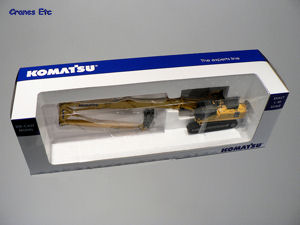 | | The model comes in an a window box. |  | 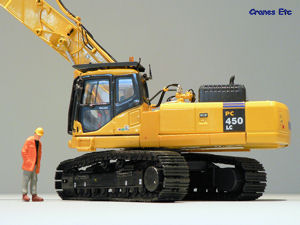 | | Metal tracks are very good. | 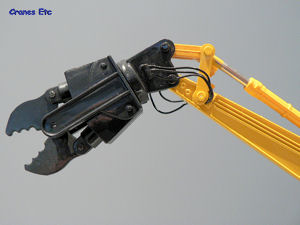 | | Demolition jaws open and close. They are plastic. | 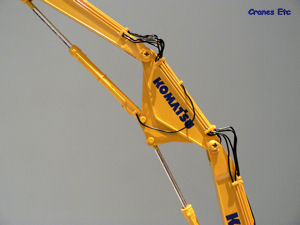 | | Excellent hydraulic hoses throughout, although marred a little by the large crosshead screws. | 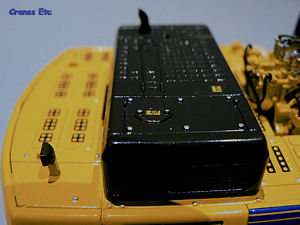 | | Incredible small markings - click the photo to see in more detail. | 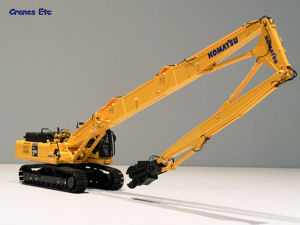 | | No problem holding up the boom without any cylinder bleed. | 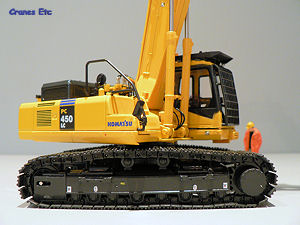 | | The level of detail sets the model apart from others. |
| The Komatsu 450 LC is demolition machine with an operating weight in the range of 48-69 tonnes depending on the boom length and other options. As a demolition machine it is designed to cope with the additional loads and stresses that arise from that type of duty cycle.
Packaging
The model comes in a box with a window which allows the model to be seen inside. The model is securely held within expanded polystyrene trays with clear plastic spacers. Interestingly the box is labelled 'The experts line' suggesting this range is intended to be of premium quality, and the scale is described as 'Exact 1:50 Scale'. There are no instructions supplied with the model and no assembly is required.
Detail
The first impression of the model is how light it is compared to other models of similar machines and the reason for this is that the model uses rather more plastic than would normally be expected. However this is use of plastic in a precision way - the other initial impression of the model is that it is exceptionally detailed.
The tracks are metal and look good. They are mounted on plastic frames and in fact the whole undercarriage is plastic. There is greater detail than usual however, including tiny graphics some of which are barely a millimetre wide. The theme of enhanced detail continues with the operator's cab which is again an all plastic item. Inside the controls are clearly delineated and the windows even have small warning notices applied. On the outside the mirror, beacon light and aerial are all finely detailed. Behind the cab the body becomes metal (presumably to counterbalance the demolition boom) and there are many small graphics applied. Along the bottom of the body there are heavy duty side guards as provided on the original machine. The roof of the body reverts to plastic and again the detail increases.
The detail in and around the boom connection to the body is exceptional. A multitude of finely sized hydraulic lines lead into realistic looking valves. The main hydraulic cylinders which raise the boom have hydraulic lines within the moulding and a number of lines connecting them to the body. Moving to the boom, this is a three section piece and is all plastic. Similarly the intermediate section and demolition arm are also plastic. The level of detail is very high with the only black mark being the screws used to join the main parts together which, although painted, are quite visible. All cylinders on the boom are connected by realistic hydraulic lines. The only item obviously missing is the connection between the boom and demolition arm which is used to clip them together when the machine is transported.
The jaws are heavy looking but again they are plastic.
Features
The crawler tracks work well and are reasonably free rolling on the frames. One of the sprockets is spring loaded so removing the tracks is relatively straightforward. Sadly the track frames are not extendible and are in the transport position only. Although this does not adversely affect the stability of the model the width between tracks looks narrow from some angles.
The operator's cab can be tilted like the cab on the original but the mechanism appears to be achieved by flexing a plastic connection and as such the tilt is quite small and cannot be maintained. It is possible to pose the model with a tilted cab by pushing a spacer under the cab but care has to be exercised as it feels as though something may snap if the cab is pushed back too far.
All parts on the demolition boom and arm work including rotation of the tool and opening and closing the jaws. The model can be posed in almost any way with the lightweight nature of the plastic construction meaning that there were no cylinder bleed or stability problems on the review model. However the scaling of the model is not quite spot on as the demolition arm cannot be folded right up to replicate the transport mode of the original machine which is a little disappointing, although the model does look credible on a low loader. Similarly it is not straightforward to detach the boom as on other models.
Quality
Komatsu and Universal Hobbies have adopted a different approach on the range of models which includes this machine. The majority of the model is plastic and although this would normally be equated with lower quality, the trade off in its favour is exceptional detail. Also some of the lettering and markings are incredibly small. The use of plastic works because the quality of the paint finish applied means that visually it is hard to tell what each part of the model is made of. Mechanically it feels less robust than the usual diecast construction and you would not want to apply too much pressure to some of the moving parts for fear of breakage.
Price
One of the advantages of the use of plastic within the model is that it offers a significant price advantage. It is typically two thirds of the cost of the cost of a comparable diecast model of this type.
Overall
This a welcome addition to the scale model world given the relatively few demolition machines that have been available and the Komatsu is a good machine to see represented. Visually the model looks very good indeed with some of the fine detailing being at the top of the standard in 2007. The model poses well in any position with the only small let-down being the inability to fold up completely for transport.
The model is described on the box as a diecast model and in terms of the amount of metal used it is barely that. Much of the model is made of plastic and this has less of a quality 'feel' and is less robust than metal, although paint chips will be fewer. Ultimately it is up to individual collectors how they feel about the ratio of plastic and metal in this model. Certainly the detail level is very high and the model is highly recommended to collectors who want a model faithful to the original at an economic price.
Footnotes
The model first appeared at BAUMA in April 2007 and it was available at retailers from September 2007.
|
| |
| 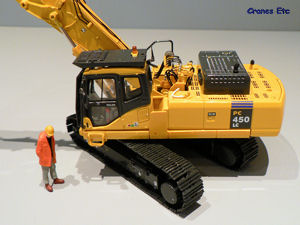 | | Visually, the model sets a very high standard for detail. | 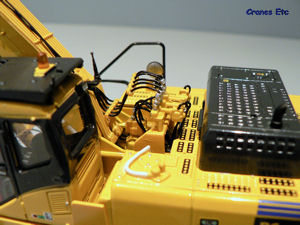 | | A close up view of the hydraulic line connections shows excellent miniature valves (view the big photo by clicking above). | 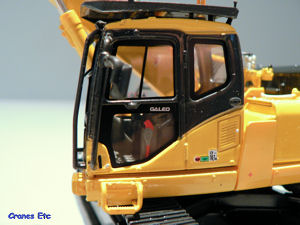 | | Cab detail is excellent with tiny transfers stuck on windows (click to see the large photo). | 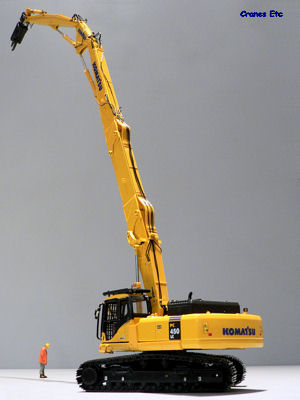 | | The boom and arm are plastic parts but it does mean the model is very stable. | 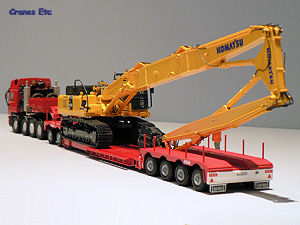 | | It looks alright on a Nooteboom low loader but the boom cannot fold enough to get it right down. |
|

